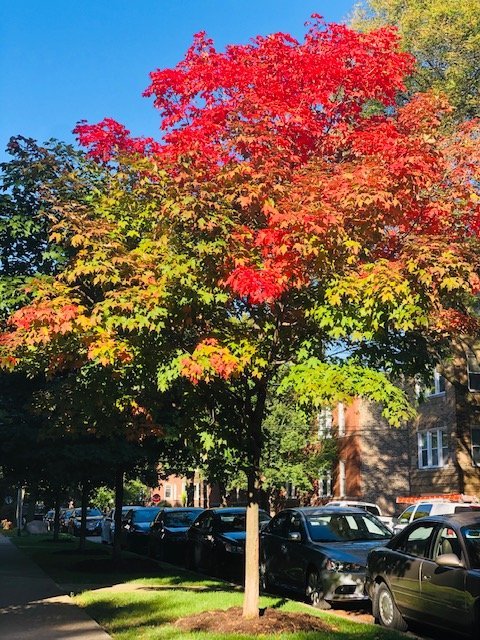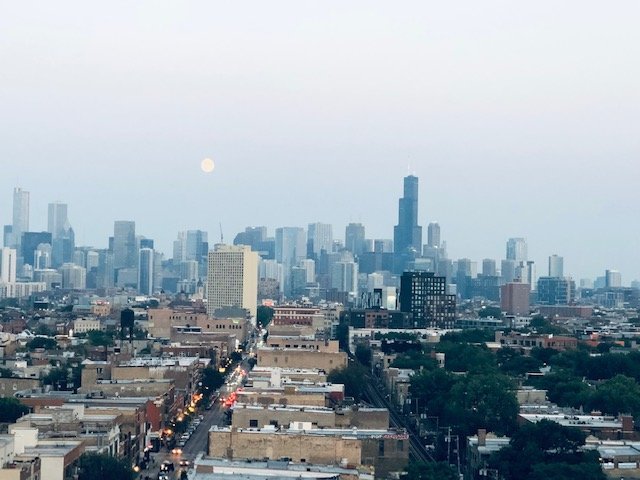The Essential Health Measure Right in Your Backyard
It’s easy to take the backdrop for granted - observe and immerse yourself instead
Fall in Chicago is always bittersweet. For one brief blip in the year, the autumn hues are vibrant, the air is pleasantly crisp, and cozy clothes make a welcome comeback. It’s that time of year that after the rat race that is ‘summer in the city’ starts to wind down, we’re ready to slow down and couch out for a bit, bracing ourselves for the legendary Midwest winter on the other side of this colorful intermission. Whether you’re ready for a break from margaritas, or it’s just too uncomfortable to get going for a walk in 40º weather, it’s easy to start rattling off excuses for why we don’t want to leave the concrete fortress. Just know that in doing so you may be hindering your health progress by cutting off your access to a massively underappreciated health management resource: Nature.
When my clients talk about their stress, anxiety, fatigue, lack of sleep, or I observe some general malaise, I’ll often blurt out, When was the last time you were by a tree?! I usually get a quick chuckle as it’s thought I’m asking in jest (being a little absurd does seem to capture attention), but I want to underscore the importance of what greenspaces do for our health, why we’re falling short on this essential health measure, and what we can do when barriers to access seem difficult to overcome.
It might not be Vermont in October, but watching the leaves change in Chicago always feels like a lucky sight to behold
Studies consistently show that regular exposure to nature can relieve stress, reduce mental fatigue, boost positive affect, happiness, and well-being, promote social interactions, cohesion, and engagement, offer a sense of meaning and purpose in life, improve manageability of tasks, decrease mental distress, promote better cognitive functioning, increase memory and attention span, foster creativity, help control impulsive behaviors, boost the immune system, improve sleep, reduce cardiovascular disease, and help to reduce obesity. The last three points are paramount as they are among the top health priorities facing our country today.
That’s a pretty impressive list of benefits we can accrue just by going outside. We now have a great deal of evidence that neighborhoods that are “greener” or have more parks are correlated with greater social cohesion and stronger social networks, and that a positive relationship exists between social connectedness and better health. There’s also mounting research demonstrating that nature plays a causal role in improving mood in the short term (more research needs to be done on long-term effects). Knowing this, we have to look at our exposure to nature as an essential health measure – I’m terming it this because it’s analogous to essential amino acids, or essential fatty acids—your body cannot make it on its own, can’t reap the rewards without them, and therefore must be consumed and continually replenished through diet. Likewise, it’s hard to find a better health resource that confers the myriad benefits than a few minutes of intentional immersion in nature can give. Your environmental diet matters.
But therein lies a problem: so many of us don’t have the discipline to spend intentional time in nature. Which is the real shame, as studies have demonstrated that the physical activity you get from being outdoors may only be partly responsible for the health benefits. Some research suggests that it’s the sense of awe and mystery we experience in nature that lends itself to the many benefits. “Attention Restoration” is a theory that says our excessive concentration leads to “directed attention fatigue” and that when we’re immersed in nature it lets our minds escape, and engages a less rigorous, indirect form of attention, facilitating recovery of our attentional capacity. Meaning, we feel refreshed, energized, and can perform tasks better. What’s even more interesting, it’s been demonstrated that physical activity done outside has more health benefits that doing the sameexercise, with the same level of exertion, inside. And don’t forget that if the sun is shining, you’re also reaping all that sweet, sweet Vitamin D.
I spy one of the tallest buildings in the world behind this perfectly zen respite
I would also venture to guess that the relaxing nature of well, nature, allows us to breathe more deeply, down-regulating the nervous system. When we have these opportunities to kind of, manually decelerate the whole system, we always see improved health outcomes. Remember that the nervous system is the one that runs the whole show- much of our health is predicated on how optimally it functions, so the better we are at regulating it, the better we feel overall. And the better we feel, the more inclined we will be to take best care of our bodies. Just being around nature appears to have many of the same benefits as meditation. So if you’re not feeling up for 20 minutes of focused breathwork, perhaps sitting in your backyard or a nearby park is more palatable.
What’s the person-to-tree ratio in Chicago?
I know I’m not alone in struggling with attention capacity and focus. Not only is rapid urbanization impeding our access to nature, as of 2016, it is estimated that we spend >90% of our time indoors (at home or in vehicles). What’s more: total media consumption per day for the average American adult in 2018 was an eye-popping 11 hours 06 minutes! And that was before a global pandemic, when we really ramped up - tallying 13 hours 21 minutes per day in 2020 (which I hope, with good reason, is an outlier). Unfortunately what we’re seeing now is that this creates a negative feedback loop. The fewer experiences we have with nature, the less likely we are to seek it out. How much more sedentary can we be? Between the lack of access and fewer experiences, the importance of what nature does for us slips away like trying to recall a dream an hour after you’ve woken up. I vaguely recall some bright colors, maybe there was a bird? Or was it a plane?
Recall that exhaustive list of benefits from being in nature. Another way we can supercharge those benefits is by experiencing nature alone. While many of us spent the last year and half cooped up without much physical social contact, many of us were also locked between four walls with other people, not getting the solace of alone time. It’s important to not confuse being alone with loneliness— loneliness has been shown to negatively impact health, while being alone can offer benefits like improving social relationships, creativity, confidence, and emotional regulation. It’s that emotional regulation part that helps us sort through emotions and interact better with others. Important to note is that these benefits occur when we choose to spend time alone, because we then view that experience in a positive light, reducing levels of stress and potential burnout.
Experiencing the city at it’s quietest - going for a walk during a snowstorm
We are certainly social creatures, but that doesn’t mean we’re only social creatures. A symbiotic relationship exists between being social and being alone. When we’re alone (without music or a podcast going), we can feel uncomfortable with the lack of stimulus. One University of Virginia study found that 25% of women and up to 66% of men would rather give themselves an electric shock over spending time alone with their thoughts. But we also know that being alone is among some of the most restful experiences we can have —and our brains need rest and recovery, just like our bodies aren’t meant to strenuously workout seven days a week. It’s a time with no pressure, no obligations, no external judgement. This is the best time to develop your sense of self, discover your own interests, and evaluate what relationships are most important in your life.
My friends know I protect my Friday nights at all costs. Friday nights are the night of the week I cocoon up alone working on mobilty/stretching, doing my at-home facial and hair treatments, reading, cleaning, listening to podcasts, making a healthy dinner, and watching some TV. Because most of my days are spent directly interacting with people, I look forward to this night every week to feel restored. I don’t talk on the phone and I don’t text, this time is that sacred to me.
I have to be intentional with my discipline regarding limiting technology use and being present in nature. Because like most activities that benefit our health, the payoff is worth the patience, worth the guaranteed initial discomfort (don’t forget that we earn our health, and most things we have to earn are not always easy at first). On weekend mornings when the weather is at least warm enough to be outside in a couple easy layers, I’ll sit outside on my balcony with a cup of tea or coffee and watch the birds fly through the trees, seeing how long I can sit and let my mind wander without picking up my phone. When I first started the practice, I swear I had been outside for 30 minutes. It was less than 10. It seems time distortion during this exercise is more exaggerated than it is with meditation. I’ll observe nature for a while, letting my mind dance through a sort of free association mental gymnastics. It feels both similar to, and the exact opposite of, meditation. With meditation, focus is repeatedly returned to a particular point; while I observe nature, however, I give my mind free reign to go wherever it goes, on it’s own accord, without the stimulus of someone else. Some of my most creative ideas have come from those mornings. And while I rarely (read: never) feel excited to start the “exercise” – I am always, always, happy I put the effort. I feel calmer, happier, more creative, and somehow also more energized.
That one year I overzealously turned the balcony into a botanical garden, no regrets
If you find yourself struggling to lace up your shoes for outdoor exercise, try reframing the purpose of why you’re outside. The walking, running, cycling, is an additional benefit to being outside, but remember that the immersion in nature itself can bring tremendous reward. Especially if you live in an urban area, reframe your exercise time as just a time to see the beautiful colors of autumn, or notice what squirrels do when you watch them for more than a second, because the benefits accrued are numerous and noticeable. Or frame it as time for you to be alone, in a different setting. It’s your time, your time to put yourself front and center, unimpeded. Because psychological studies show that when we’re moving and thinking it helps us process our thoughts better, I recommend not listening to music or podcasts during this time Where does your mind go? Can you provide enough self-stimulation with your own mind, your own curiosity? Or do you need the constant drip of spoon-fed stimulation? Even during the infamous Chicago winters, getting a peek of the city snowscape feels like you’re in a Kinkade come to life. We’re right around the corner from the annual ubiquitous gripes of shorter daylight hours, freezing until your bones hurt, extreme boredom, and of course the perennial favorite, holiday weight gain. So maybe before we close the windows for the next six months, capitalize on this perfect time of year. The discipline reaps dividends.
Pretty sure some very famous paintings look exactly like my neighborhood last winter







